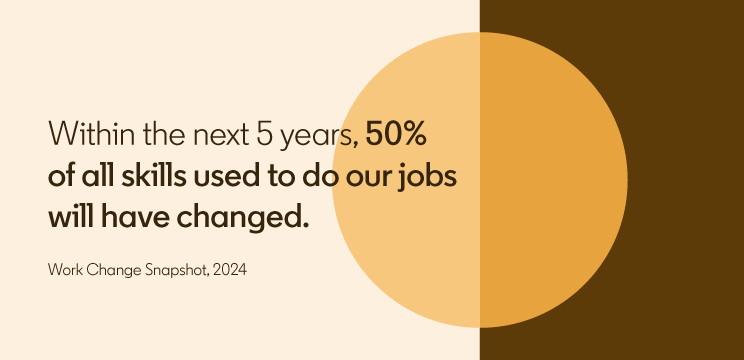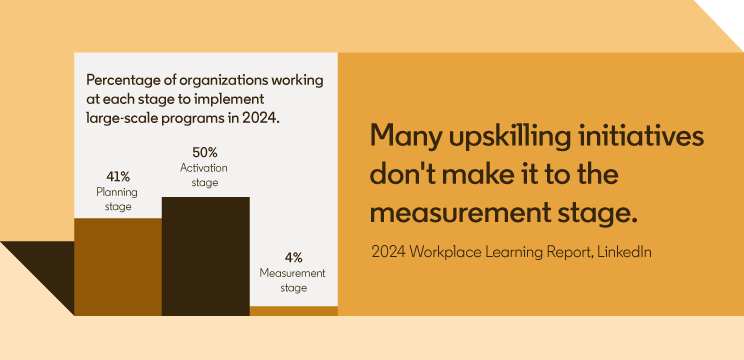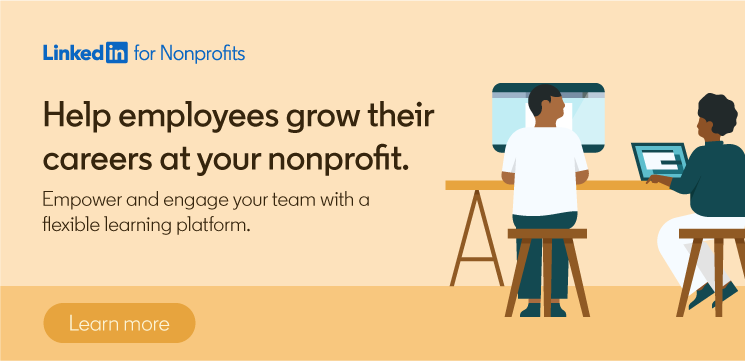
Developing Nonprofit Talent Starts with a Solid Plan
Offering career development opportunities can be an excellent way to retain current staff and attract new talent. But it won’t happen on its own. For your organization to successfully put an employee development program into motion, laying the proper groundwork is key. First, you need to define your nonprofit talent strategy.
It’s fine to start small, and it’s normal for your strategy to evolve over time as your nonprofit’s needs and goals change, so don’t worry about having all the answers right away. Read on for tips to help you start planning your nonprofit talent strategy — and learn why this approach can help your organization stay ahead of the curve.
The impact of nonprofit talent strategies at nonprofits
At nonprofits and for-profit companies alike, retaining top performers is a big challenge. LinkedIn’s 2024 Workplace Learning Report found that 90% of organizations are concerned about employee retention, with learning opportunities being the number one retention strategy used to combat this challenge. These opportunities can play a key role in your employer branding effort, too, since job candidates are often drawn to roles that offer the room and resources for growth.
At cause-driven organizations, a learning-centric culture may also help to continually renew employees’ engagement in their work. The Workplace Learning found that:
7 in 10 respondents say learning improves their sense of connection to their organization.
8 in 10 say learning adds purpose to their work.
As you make a business case for investing in learning and development at your nonprofit, it’s worth noting that the skills required for jobs are evolving fast. In fact, LinkedIn data shows that within the next 5 years, 50% of all skills used to do our jobs will have changed.
Helping your team keep their skills up to date benefits both them and your nonprofit. It all starts with the right plan.

Tips for creating your nonprofit development strategy
To ensure the smooth implementation of your nonprofit learning and development strategy, aim to fold in these proven best practices from the very start.
Build learning and development into the employee experience from the start.
When the learning aspect of a role feels like an added obligation or afterthought, team members are less likely to engage with it enthusiastically. Avoid this by making professional growth central to the experience of working with your nonprofit. Include it in your employer brand messaging. Talk about it during interviews. Incorporate it into the onboarding process.
These early stages of your relationship with a new hire are ideal moments to align on career goals and highlight the support and opportunities you offer to help achieve them. The 2024 Workplace Learning Report found that learners who set career goals engage with learning 4x more than those who don’t. It’s also a good way to get your new hire thinking about the long-term growth they could achieve at your nonprofit — and demonstrate that you’re invested in that growth.
Make learning plans customizable and give personal ownership over goals.
To help your nonprofit staff feel motivated and invested in their professional development, give them agency over it. One of McKinsey & Company’s six power practices to retain nonprofit talent is “personal ownership.” McKinsey shares this example to illustrate how the approach works in practice:
“A nonprofit introduced five-year professional development plans that enable staff and leadership to have structured, forward-looking discussions about staff’s aspirations and passions. Professional development plans helped reinforce ownership mindsets among talent, who could see how their development links back to delivering the organization’s goals.”
This example demonstrates an important aspect of employee development: it should tie directly to both the individual’s personal career objectives and the nonprofit’s mission and goals. Ensure managers are equipped to have conversations with their direct reports to understand their unique goals, then map those goals back to organizational priorities. This is a stage where documented planning is essential to ensure alignment and keep things on track.
Provide easy and flexible access to learning resources.
As you’re planning your nonprofit learning and development strategy, choosing the right learning resources to deliver on that strategy is critical. In-person sessions can be valuable, especially for organization-specific training, but their time- and location-bound nature can make them difficult to scale.
As such, many nonprofits ultimately opt for a mix of different learning resources, including online courses like those offered through LinkedIn Learning. These courses are:
- Easy to access and available on demand, so learners can engage with the content at their convenience and set their own pace.
- Expert led, covering a wide range of skill areas and proficiency levels.
- Available in multiple languages to meet the needs of a diverse workforce.
In addition to providing skill development resources, consider factoring development techniques like mentorship programs into your plan to empower peer-to-peer learning.
Measure and review progress regularly.
For a learning strategy to be successful in the long term, the burden can’t fall on employees to track and measure their progress alone. Unfortunately, the 2024 Workplace Learning Report found that while an increasing percentage of organizations are planning large-scale upskilling initiatives, many struggle to reach the measurement stage.
Commitment and follow through are key. At the individual level, encourage managers to work with their direct reports to set SMART goals together, then meet regularly to discuss progress. Focus on making these goals measurable and achievable by setting specific achievement criteria in timelines, but build in the flexibility for learning plans and personal goals to evolve if priorities shift.
At the organizational level, start by setting goals for implementation, then determining how you will meet those goals. If you’re using LinkedIn Learning, for example, consider setting a goal for what percentage of users you want to activate their license by a certain date. Then, build interest in the resource by communicating why employees should care via your internal channels. One Canadian nonprofit did this by sending an email sharing the wide range of courses available and encouraging employees to “learn whatever they wanted to learn,” while a nonprofit in the UK leveraged calendar moments like Mental Health Awareness Week to spotlight relevant content and get people curious about what else was on offer.
After you’ve successfully implemented your learning strategy, keep measuring. Evaluate engagement with your learning resources at a team and organization-wide level on an ongoing basis to identify opportunities for improvement and reinforcement. You can also build learning into your employee recognition efforts, performance reviews, and promotion decisions, ensuring that staff continue to feel that learning is a priority for your organization — and a great way to grow their career with you.
For more tips on planning your nonprofit talent development strategy and bringing it to life, check out LinkedIn’s career development resources and discounted learning solutions for nonprofits.


